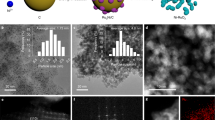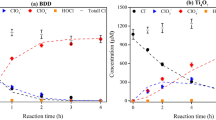Abstract
A series of four electrolytic reduction runs was performed in molten salt at bench scale to compare the performance characteristics of monolithic platinum and iridium as oxygen-evolving anodes, while simultaneously reducing uranium oxide to metal. In each run, 25 g of uranium oxide particulate was loaded into a permeable steel basket, which, in turn, was immersed in a pool of LiCl—1 wt% Li2O at 650 °C. Both anodes, each 3 mm in diameter, were suspended vertically in the salt pool, adjacent to the steel cathode basket. The anodes were connected in parallel to separate direct current power supplies with the uranium oxide-loaded basket as the common cathode. A cell voltage (3.1 V) was intermittently applied to the system with both power supplies operating concurrently, effecting the reduction of uranium oxide to uranium metal at the cathode basket and the simultaneous oxidation of oxygen anions in the salt to oxygen gas at each anode. Anode and cathode potentials and currents were recorded to compare the performance of platinum vis-à-vis iridium. After completing the series of runs, both anodes were removed and subjected to dimensional, chemical, and microscopic analyses. Even though the accumulated charges on each anode over the series of four runs were similar, the platinum anode exhibited up to 29% reduction in cross-sectional area compared to < 3% for the iridium anode.
Graphical abstract










Similar content being viewed by others
References
Gourishankar K, Redey L, Williamson M (2002) Electrolytic Reduction of Metal Oxides in Molten Salts. In: Schneider W (ed) Light metals 2002. The Minerals, Metals and Materials Society, Pennsylvania, pp 1075–1082
Goff KM, Wass JC, Marsden KC, Teske GM (2011) Electrochemical processing of used nuclear fuel. Nucl Eng Technol 43:335–342
Williamson MA, Willit JL (2011) Pyroprocessing flowsheets for recycling used nuclear fuel. Nuc Eng Technol 43:329–334
Inoue T, Koyama T, Arai Y (2011) State of the art of pyroprocessing technology in Japan. Energy Procedia 7:405–413
Sakamura Y, Omori T (2010) Electrolytic reduction and electrorefining of uranium to develop pyrochemical reprocessing of oxide fuels. Nucl Technol 171:266–275
Lee H, Park G-I, Kang K-H, Hur J-M, Kim J-G, Ahn D-H, Cho Y-Z, Kim EH (2011) Pyroprocessing technology development at KAERI. Nucl Eng Technol 43:317–328
Choi E-Y, Jeong SM (2015) Electrochemical processing of spent nuclear fuels: an overview of oxide reduction in pyroprocessing technology. Prog Nat Sci-Mater 25:572–582
Nagarajan K, Reddy BP, Ghosh S, Ravisankar G, Mohandas KS, Mudali UK, Kutty KVG, Viswanathan K, Babu CA, Kalyanasundaram P, Rao PRV, Raj B (2011) Development of pyrochemical reprocessing for spent metal fuels. Energy Procedia 7:431–436
Herrmann SD, Li SX (2010) Separation and recovery of uranium metal from spent light water reactor fuel via electrolytic reduction and electrorefining. Nucl Technol 171:247–265
Herrmann SD, Li SX, Westphal BR (2012) Separation and recovery of uranium and group actinide products from irradiated fast reactor MOX fuel via electrolytic reduction and electrorefining. Sep Sci Technol 47:2044–2059
Sakamura Y, Kurata M, Inoue T (2006) Electrochemical reduction of UO2 in molten CaCl2 or LiCl. J Electrochem Soc 153(3):d31–d39
Jeong SM, Shin H-S, Cho S-H, Hur J-M, Lee HS (2009) Electrochemical behavior of a platinum anode for reduction of uranium oxide in a LiCl molten salt. Electrochim Acta 54:6335–6340
Lee S-K, Jeon MK, Kim S-W, Choi E-Y, Lee J, Hong S-S, Oh S-C, Hur J-M (2018) Evaluation of Pt anode stability in repeated electrochemical oxide reduction reactions for pyroprocessing. J Radioanal Nucl Ch 316:1053–1058
Outotec (2015) HSC chemistry 8. Outotec, Pori
ASM International (2016) ASM alloy phase diagram database. Villars P (ed) https://matdata.asminternational.org/apd/index.aspx
Kasuyu R, Miki T, Morikawa H, Tai Y (2013) Synthesis of alkali metal platinates and their dissolution behavior in hydrochloric acid. J Ceram Soc Jpn 121(10):884–890
Freund F, Williams SC, Johnson RD, Coldea R, Gegenwart P, Jesche A (2016) Single crystal growth from separated educts and its application to lithium transition-metal oxides. Sci Rep 6:35362. https://doi.org/10.1038/srep35362
O’Malley MJ, Verweij H, Woodward PM (2008) Structure and properties of ordered Li2IrO3 and Li2PtO3. J Solid State Chem 181:1803–1809
Kobayashi H, Kanno R, Tabuchi M, Kageyama H, Nakamura O, Takano M (1997) Structure and charge/discharge characteristics of new layered oxides: Li1.8Ru0.6Fe0.6O3 and Li2IrO3. J Power Sources 68:686–691
Takayama T, Kato A, Dinnebier R, Nuss J, Kono H, Veiga LSI, Fabbris G, Haskel D, Takagi H (2015) Hyperhoneycomb iridate β-Li2IrO3 as a platform for Kitaev magnetism. Phys Rev Lett 114:077202
Modic KA, Smidt TE, Kimchi I, Breznay NP, Biffin A, Choi S, Johnson RD, Coldea R, Watkins-Curry P, McCandless GT, Chan JY, Gandara F, Islam Z, Vishwanath A, Shekhter A, McDonald RD, Analytis JG (2014) Realization of a three-dimensional spin-anisotropic harmonic honeycomb iridate. Nat Commun 5:4203. https://doi.org/10.1038/ncomms5203
Acknowledgements
This work was supported by the U.S. Department of Energy (DOE), Office of Nuclear Energy, under DOE Idaho Operations Office contract DE-AC07-05ID14517.
Author information
Authors and Affiliations
Corresponding author
Additional information
Publisher’s Note
Springer Nature remains neutral with regard to jurisdictional claims in published maps and institutional affiliations.
Rights and permissions
About this article
Cite this article
Herrmann, S.D., Tripathy, P.K., Frank, S.M. et al. Comparative study of monolithic platinum and iridium as oxygen-evolving anodes during the electrolytic reduction of uranium oxide in a molten LiCl–Li2O electrolyte. J Appl Electrochem 49, 379–388 (2019). https://doi.org/10.1007/s10800-019-01287-1
Received:
Accepted:
Published:
Issue Date:
DOI: https://doi.org/10.1007/s10800-019-01287-1




